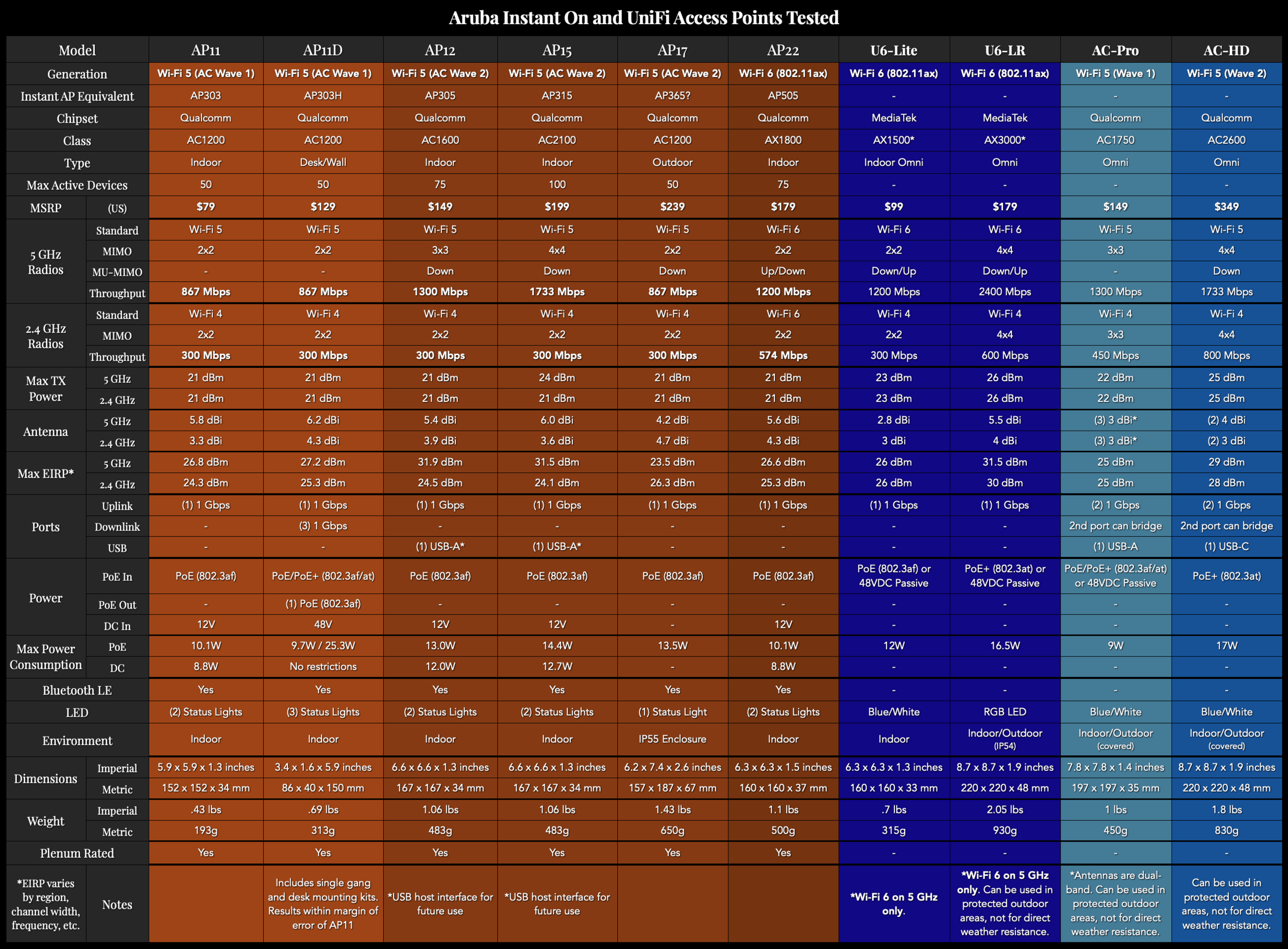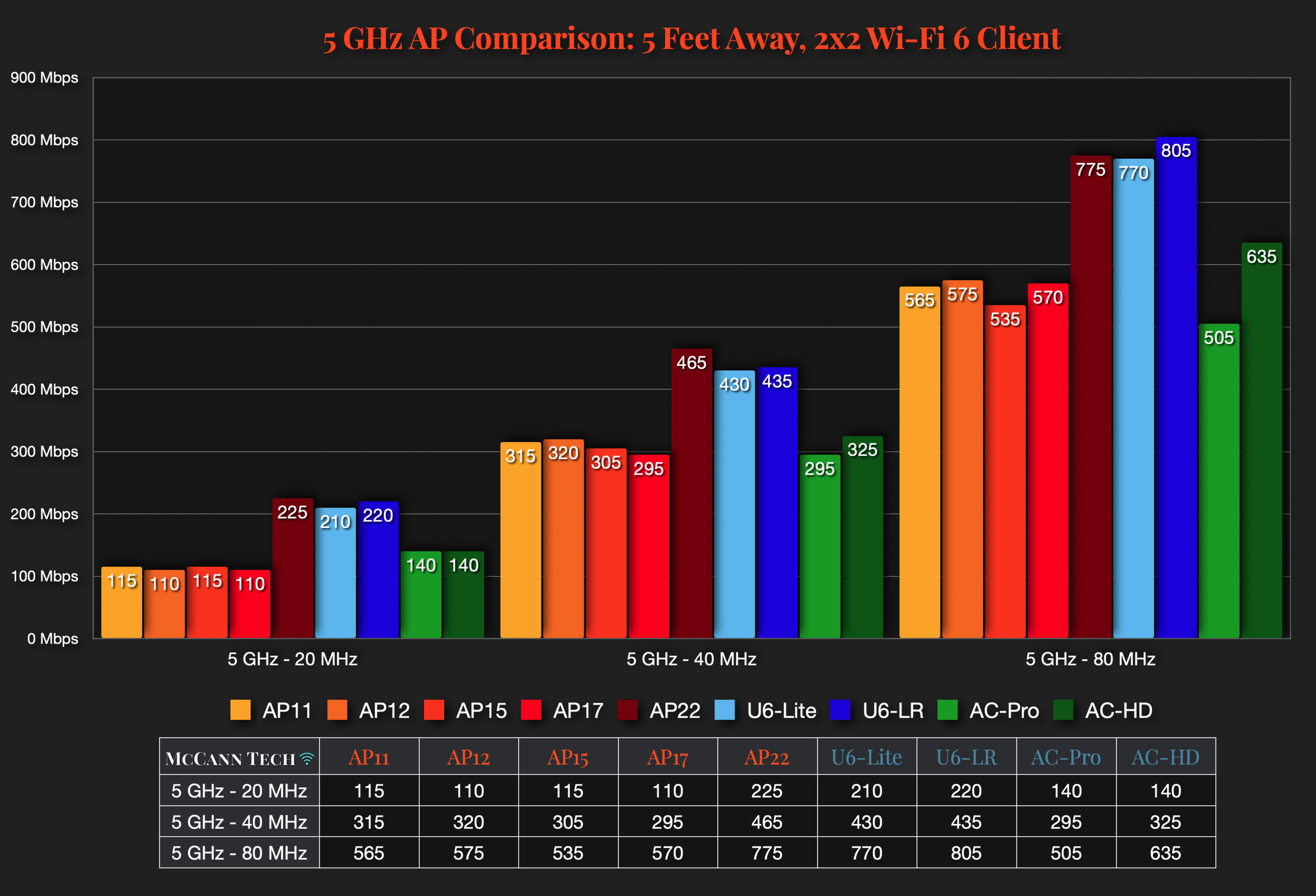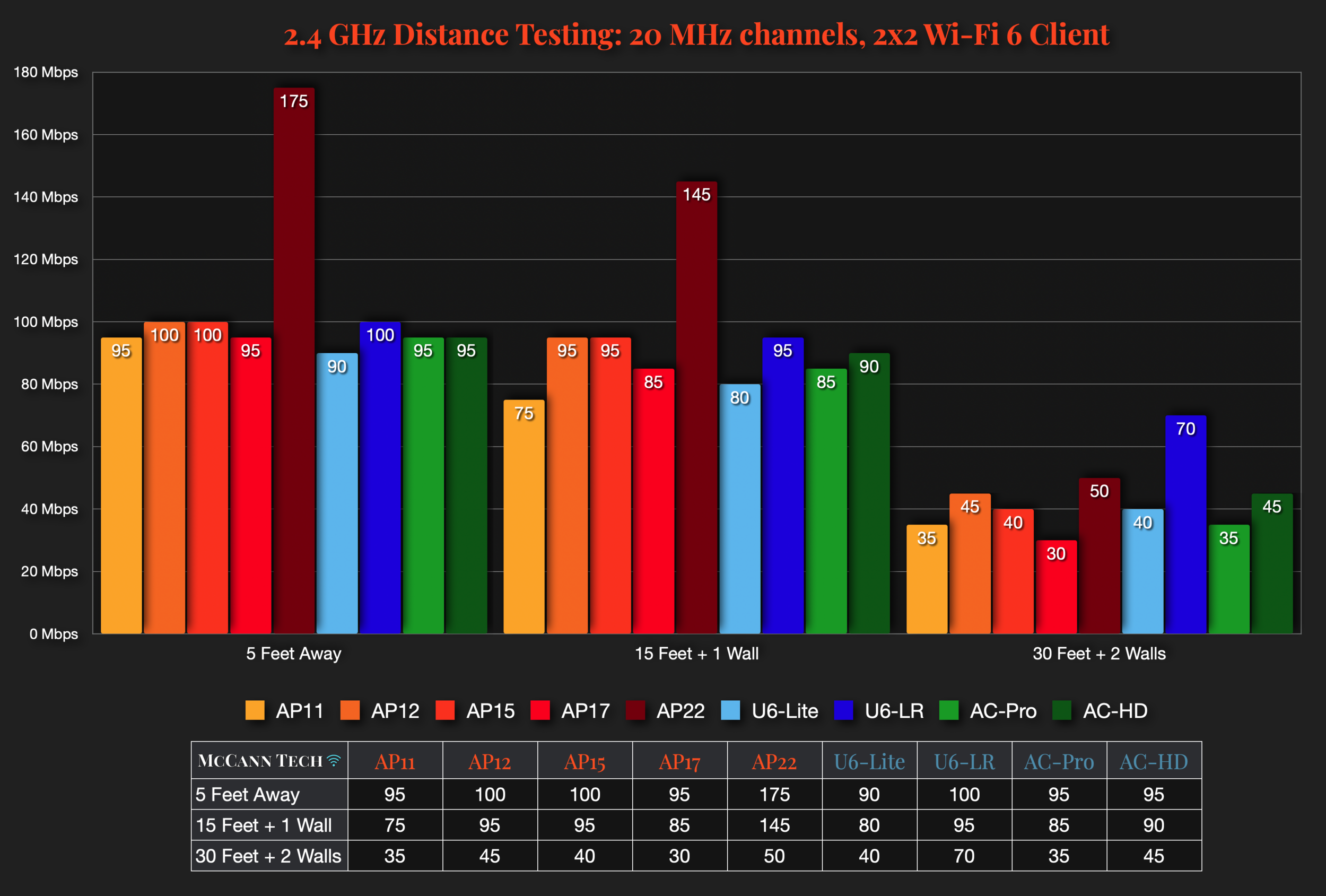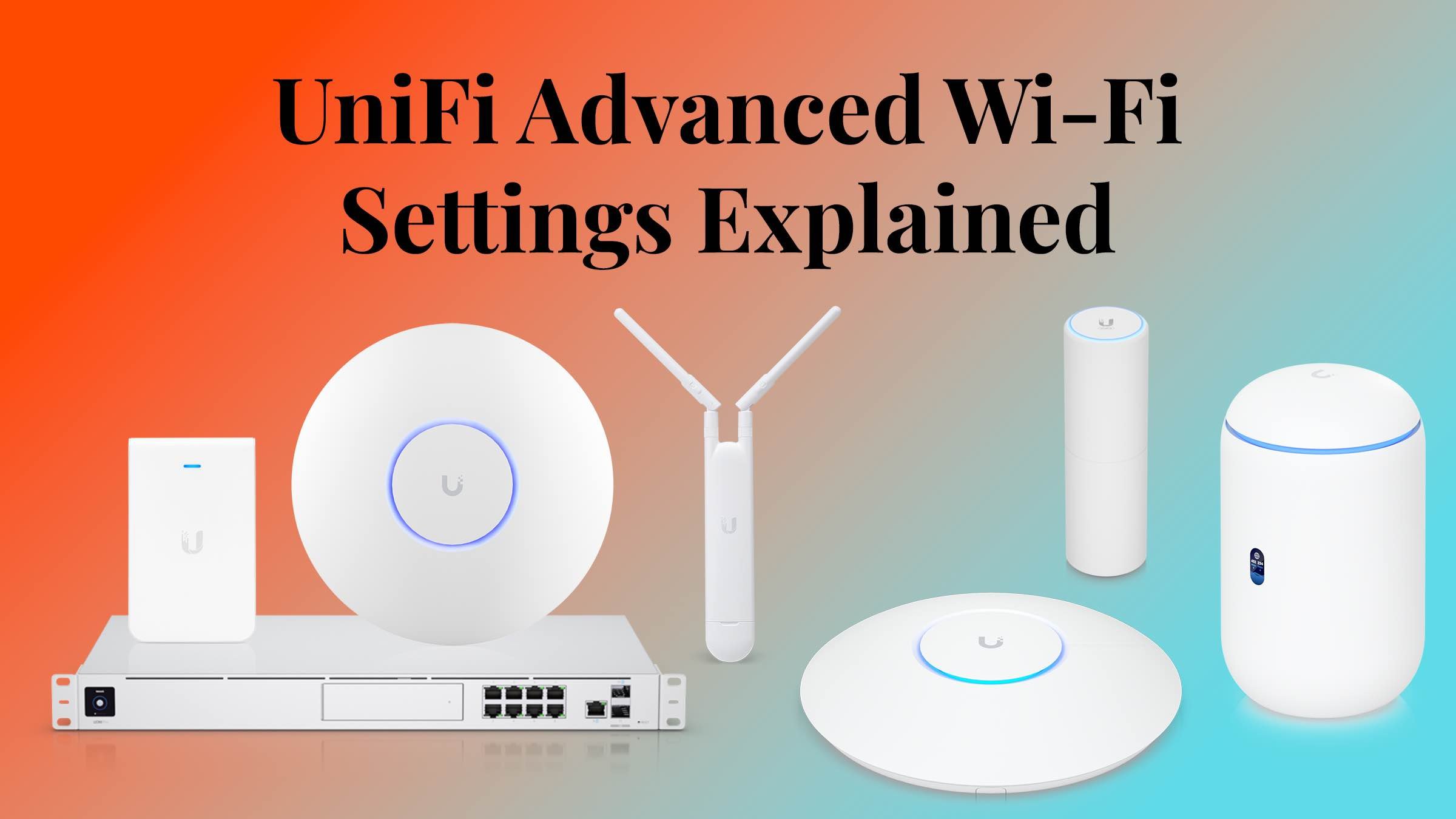Wi-Fi Speed Tests — Aruba Instant On vs. UniFi
Originally Posted: July 25th, 2021
Last Edited: August 29th, 2021
TL;DR:
Instant On offers switches and APs with basic cloud-managed software. Instant On switches can be managed locally, but their APs are cloud-only.
UniFi offers routers, switches, APs, security cameras, access control, and VoIP phones with local or remote management. UniFi software has more features, but also more bugs.
The early Wi-Fi 6 models (AP22, U6-Lite, U6-LR) usually perform the best, but there are situations where a higher spec’d Wi-Fi 5 AP can outperform them.
Overall, the AP22 has the best 2.4 GHz performance, and the U6-LR and AC-HD have the best 5 GHz performance.
Wi-Fi Speed Tests — Aruba Instant On vs. UniFi
If you’re not familiar with Aruba, check out my Instant On Overview for more details. I also covered the Instant On software and my overall thoughts in my Instant On AP22 Review. This review focuses on the Wi-Fi access points and performance.
For testing, I’m comparing all available Instant On APs to UniFi’s Wi-Fi 6 U6 Lite and U6 Long Range, as well as UniFi’s older Wi-Fi 5 AC-Pro and AC-HD. I used local iPerf tests and public speed test servers at multiple locations, and with multiple devices. Let’s start by looking at the specs of all of the models, and how they compare.
UniFi AC-HD (left), Instant On AP22 (middle), AP11D (top right), AP11 (right), and an Instant On 1930 Switch.
Comparison of APs Tested
Wi-Fi 6 Models
Wi-Fi 5 Models
There are 6 Instant On APs to pick from, and their model numbers mostly go in order. The first number is their generation (1 or 2), and the 2nd number is their place in the line up. Generally speaking, higher number = higher specs, and higher price.
Starting at the bottom we have the $79 AP11 (AC1200, 2x2), which has a variation known as the AP11D. The AP11D features mostly the same specs, but can be mounted on a desk or in a wall outlet. The AP11 and AP11D performed similarly, so I only showed results from the AP11. The $239 AP17 is Instant On’s only outdoor AP, which is another AC1200 model like the AP11.
The higher-end Instant On APs are the $149 AP12 (AC1600, 3x3 5 GHz) and $199 AP15 (AC2100, 4x4 5 GHz). The $169 AP22 is AX1800, with two spatial streams on each band. The AP22 is the only Wi-Fi 6 model, giving it an edge over all the other Instant On APs.
For UniFi, I tested the first Wi-Fi 6 models, the U6-Lite and U6-LR. These both skipped upgrading their 2.4 GHz radios, making them N/AX1500 and N/AX3000 APs if you want to be pedantic. I also tested the older AC-Pro and AC-HD to show some Wi-Fi 5 results. See the charts below for their full spec differences.
Single Client Speed Tests and Throughput Graphs
For Wi-Fi 6 client performance, the main comparision to watch is the AP22 vs. the U6-Lite and U6-LR. The AP22 is a 2 spatial stream AP like the $99 U6-Lite. The $179 U6-LR is a bit more expensive, but has the advantage of 4 spatial streams on it’s 5 GHz radio. The U6-LR also has a slight edge in transmit power and a few other areas. The AP22 is usually available around $160, so it fits between the two models in price. The AP22 is the only AP with Wi-Fi 6 support on it’s 2.4 GHz radio, though.
For Wi-Fi 5 performance, all the other Instant On APs are compared against the UniFi AC-Pro and AC-HD. The $149 AC-Pro is an older 802.11ac Wave 1 AP, offering 3 spatial streams on it’s 2.4 GHz and 5 GHz radios. The AC-HD is a newer AC Wave 2 model, offering 4 spatial streams on both of it’s radios. This isn’t the most fair of comparisons as the AC-HD retails for $349, but it gives you an idea of what a higher-end Wi-Fi 5 AP can deliver. The $79 AP11 is the cheapest AP here, so keep that in mind when viewing the test results.
In all the speed test charts that follow, the numbers I’m showing are throughput in Mbps, averaged over five or more minute-long local iPerf TCP tests. I went over these numbers multiple times, and I tried to make them as accurate as possible. You won’t necessarily see the same results on your network with your devices, but it should give you a general idea of expected performance. Keep in mind that these numbers represent averages rather than exact measurements. I cover my testing setup at the end of the article if you’re interested in more details about how and why I test this way.
The first few tests cover an ideal scenario, with a nearby client on a clean channel. In typical use you’ll see less throughput. This is a test of the APs capability in an ideal scenario, and how much data they can deliver to a single client.
Wi-Fi 6 Speed Comparison
2.4 GHz Speed Comparison
First, I tested all of the APs on 2.4 GHz, trying both 20 MHz and 40 MHz channels. I don’t recommend using 40 MHz channels in the 2.4 GHz band, due to them overlapping with over 80% of the already-crowded spectrum. There’s only one non-overlapping 40 MHz channel in North America, and the rest of the world only has two. Like 160 MHz channels in 5 GHz, there’s just not enough available frequency for them to be reliably used in most situations.
In the best-case scenario throughput roughly doubles, but you’re more likely to have issues with interference, less range, and an inconsistent experience. Most manufacturers quoted data rates for 2.4 GHz rely on this 40 MHz channel trick. With a normal 2x2 client, you’re more likely to effectively use 20 MHz channels with 150 Mbps data rates than 40 MHz channels with 300 Mbps. Wi-Fi 6 raises that to 287/574 Mbps, but that only applies to the AP22.
Of these nine access points, the AP22 is the only one that supports Wi-Fi 6 on it’s 2.4 GHz radio. The Wi-Fi 5 standard only applied to the 5 GHz band, and the U6-Lite and U6-LR both stayed with older 2.4 GHz radios that support Wi-Fi 4 (802.11n). The results are as you’d expect, and it’s not a very close competition.
In these results you can see the impact of higher 1024-QAM modulation and the longer symbol duration of WiFi 6, resulting in a theoretical 38% increase in data rates. In most cases, the throughput difference is more like 10-20%. The difference is more extreme when you’re very close to the AP, and in an ideal scenario like I’m testing here. Since I was using a 2 stream client, the extra spatial streams in the 5 GHz radios of the AC-Pro and AC-HD didn’t come into play, besides possibly improving beamforming.
The AP22 is the only AP which can leverage Wi-Fi 6, resulting in a significantly higher max data rate (574 vs 300 Mbps when using 2 spatial streams on a 40 MHz channel), and significantly higher throughput. All the other APs are stuck at lower modulation rates, and performed similarly. The difference in real world performance isn’t going to be as big as my results would lead you to believe, but the AP22 is undeniably the 2.4 GHz champ.
Instant On vs. UniFi Speed Tests - Wi-Fi 6, 2.4 GHz. Best case scenario with a 2 stream client.
5 GHz Speed Comparison
Next, I did the same test using 20, 40, and 80 MHz channels in 5 GHz. At 80 MHz, the Wi-Fi 5 models maxed out at a typical 867 Mbps data rate, while the AP22, U6-Lite, and U6-LR top out at 1200 Mbps. You can see the impact of Wi-Fi 6 on all three channel widths, with the biggest difference being at 80 MHz. At this width, Wi-Fi 6 closes in on the gigabit barrier. It’s possible to get up to near gigabit speeds with 80 MHz channels, but throughput over 1 Gbps usually requires 160 MHz width, or a 3rd spatial stream. It also requires near-ideal conditions and short range like I’m showing here.
Also worth noting: The AC-Pro beat the AP11 with 20 MHz width, but struggled with wider channels. The AP12 and AP15 couldn’t match the AC-HD at 80 MHz. Both of those are signs of things to come.
Instant On vs. UniFi Speed Tests - Wi-Fi 6, 5 GHz. Best case scenario with a 2 stream client.
For the next test, I switched over to my MacBook Pro and it’s 3 spatial stream Wi-Fi 5 radio. This is an interesting test because it shows the impact of an additional spatial stream, and removes the highest-end modulation (1024-QAM) and longer symbol duration of Wi-Fi 6. This is a more even playing field, and a chance for the 3x3 and 4x4 APs to show their strength.
The AP12, AP15, U6-LR, AC-HD, and AC-Pro are all on equal footing in this test, offering 3 or 4 spatial streams, 256-QAM, and up to 1300 Mbps data rates to my 3x3 client. The AP12, AP15 and AC-Pro fall behind with wider channels, unable to match the U6-LR and AC-HD. The AP22 punches a bit above its weight, outperforming all the other 2 stream APs.
I expected the 3x3 AP12, 4x4 AP15, and 3x3 AC-Pro to perform better here. Their high end performance was less than I expected, and the AC-Pro actually achieved the worst 80 MHz result of the group. At smaller channel widths, these APs leverage the additional spatial stream well. At 80 MHz, they can’t compete with the U6-LR and AC-HD.
All the other APs support 2 spatial streams, making them incapable of matching the highest data rates of the higher spatial stream APs. Without the advantage of a 3rd spatial stream, the AP11, AP17, AP22, and U6-Lite fell behind. Despite this, at 80 MHz, they all managed beat the AC-Pro, and traded blows with the AP12 and AP15.
I couldn’t get my MacBook Pro to associate to a 40 MHz channel on any of these APs, so I excluded those results from this test. I believe Apple uses the “fat channel intolerant” setting on their devices. As always, 5 GHz is the best option for speed, and 40 MHz channels on 2.4 GHz should be avoided in most situations.
This chart also shows how the same 20 MHz channel width (combined with a 3rd spatial stream) can push more data over 5 GHz. This is due to Wi-Fi 5’s top data rates, which use 256-QAM modulation. 2.4 GHz wasn’t changed in the Wi-Fi 5 standard, so It typically tops out at 64-QAM, resulting in a lower data rate and lower throughput.
Instant On vs. UniFi Speed Tests - 3x3 Wi-Fi 5. Best case scenario with a 3 stream Wi-Fi 5 client.
2.4 GHz Distance Testing
For my next test, I switched back to my 2x2 Wi-Fi 6 client, and tested range by moving the APs to 3 different places in my house. I wanted to show the impact of distance from your AP on a typical Wi-Fi signal. All of the above tests were very close range, and meant to show a best-case scenario. These tests are more realistic, and the 15 feet + 1 wall results are more likely what you will see in typical use.
With every foot of free space and every obstruction, a Wi-Fi signal attenuates and gets weaker. 5 GHz signals attenuate faster, and provide around half the range of 2.4 GHz. When deciding on how many access points you need, a good general rule is don’t expect 5 GHz coverage to extend further than 2 walls or 30 feet away. 2.4 GHz signals extend this circle out a bit, but with a few walls in the way, getting low SNR links and slow performance is likely. If there is clear line of sight AP range can extend much further, but every wall imposes a dBm penalty. Wall material and quantity are usually more important than distance in a home or small business network.
Since I ran these tests for my U6-Lite and U6-LR review, I modified the location of my “30 Feet + 2 Walls” slightly, resulting in a more dramatic fall off in signal and throughput. These results show how the AP performs when it’s 2.4 GHz signal is hovering around -65 dBm RSSI and around 20-25 SNR. The lower EIRP of the U6-Lite is a limiting factor here, achieving less SNR and slightly lower modulation rates out of this less-than-ideal link. The AP22’s 2.4 GHz radio advantage lets it pulls ahead for the closer tests, but it didn’t match the U6-LR at range.
Note for International Readers
5 feet = 1.5 meters
15 feet = 4.6 meters
30 feet = 9.1 meters
Instant On vs. UniFi Speed Tests - 2.4 GHz Distance Testing.
5 GHz Distance Testing
Next, I ran the same test on the 5 GHz band with 80 MHz channels. Wider channels give you the best speeds, but also require a stronger signal for effective use. At the farthest location, the speed advantage of 5 GHz is mostly eliminated. Those results show how the AP performs when it’s 5 GHz signal is hovering around -80 dBm RSSI and around 10 SNR. From the same location 2.4 GHz connections are stronger and more stable.
When further away, you can also see the impact of beamforming from the AC-HD and U6-LR. They are able to compensate by directing transmissions towards the distant client, and the U6-LR performed the best at the furthest location. This is where the U6-LR shows it’s biggest advantage over the AP22, and where I thought the AP12 and AP15 would do better than they did. The U6-LR’s high transmit power and beamforming allow it to reach further than any of the other models I tested. A few extra dBm is enough to allow the U6-LR to effectively cover a larger area, or punch through one more wall. The AP12 and AP15 did the 2nd best at range, coming close to the U6-LR’s performance.
If I moved a bit further away, the 2.4 GHz connections would slow down, and 5 GHz connections would drop into unusable levels. Normal clients will likely roam on to the stronger 2.4 GHz at my “30 Feet + 2 Walls” range, as they should. Using Wi-Fi with an SNR around 10 dBm isn’t ideal, and the results clearly show that.
Instant On vs. UniFi Speed Tests - 5 GHz Distance Testing
Overall Winners and Recommendations
The AP22 clearly offers the best 2.4 GHz performance. 5 GHz performance depends on a lot of factors, but the U6-LR and the AC-HD performed the best overall. The AC-Pro, AP12, and AP15 all struggled with 80 MHz channels to a single client. I don’t have a reliable way to test multi-client performance yet, but they should offer more performance in multi-client tests and realistic use.
If you’re looking for an Instant On AP, the AP22 is the obvious first choice. It offers the most performance-per-dollar. If cost is most important, the AP11 is a viable option. In some cases the AP11 beats the $149 AC-Pro. Wi-Fi 6 isn’t a massive upgrade in speeds, so spending half as much on an AP11 may be the better choice for some networks.
For UniFi, the U6-Lite and U6-LR are again the obvious choices, if you can find them in stock and around MSRP. Like a lot of companies, Ubiquiti is struggling with keeping things in stock right now. If you can’t wait around to find one of their Wi-Fi models, the AC Wave 1 and AC Wave 2 models are usually available. I didn’t cover all of those models in these tests, but models like the nanoHD and FlexHD are good options, especially if high-end Wi-Fi 6 performance doesn’t matter.
Specialty: In-Wall and Outdoor
The AP11D and AP17 are for specialty use cases. If you need an AP outside or in a wall outlet, those are fine APs with decent performance. I don’t have any UniFi In-Wall APs to test, but I’ll be looking into adding some outdoor UniFi models to future tests. UniFi offers a lot more model choices for outdoor APs, and I’m a fan of the older AC-Mesh and AC-Mesh-Pros.
AP Comparisons
The most interesting comparison for Instant On APs is the AP22 vs the AP12 and AP15. I was disappointed in the performance of the AP12 and AP15 when using wider channels. The charts above only capture single-client tests, which is not the best way to show the AP12 and AP15’s strengths. Still, they weren’t able to match up against the (much more expensive) AC-HD. I wouldn’t generally recommend the AP12 or AP15 unless you’re deploying them in a dense area with a lot of devices.
The AP22 vs. the U6-Lite and U6-LR is another interesting comparison. The U6-Lite is significantly cheaper ($99 vs. ~$165), but the AP22 has a much better 2.4 GHz radio, and outperformed the U6-Lite in basically every test. The U6-LR is more expensive, but it excels at 5 GHz, and offers the most range. The AP22 is more well-rounded, and a good default option for most networks. The software is the bigger difference, but that’s a topic for another article.
If you’re able to find any of the Wi-Fi 6 models in stock around MSRP, I think they are all good access points. The U6-Lite’s weaknesses are 2.4 GHz, range, and availability. The AP22 is better, but is also priced more in line with U6-LR, and it can’t match the U6-LR’s range.
Range Comparisons
The range difference between the AP22/U6-Lite and the U6-LR is big enough that it could be the difference between needing one or two APs to cover an area. In some situations one U6-LR is better, in others one or two U6-Lite/AP22s may be better. It’s hard to make general conclusions.
In my house, one U6-LR on each floor is more than I need. With the AP22 I would still stick to one per floor, but I would consider a 2nd on the main floor for more consistent 5 GHz coverage. Rather than having one AP22 centrally located, I could have two AP22’s on either side. There wouldn’t be much difference in overall performance, so that decision comes down to where you have Ethernet cabling, and how much you care about 5 GHz coverage and speed. For larger homes or coverage extending outdoors, two APs on either side of the house would be the better option.
If you have a lower-power AP now and are considering upgrading, the AP22 should offer similar coverage. The U6-LR would likely be a step up in range, competing with all but the highest-power mesh kits.
While these test results show the difference in performance, the bigger difference is software. Fully comparing Instant On vs. UniFi software is a big enough topic it deserves it’s own article, but I’ll briefly go over the biggest differences and what each is good for.
Instant On software is reliable, cloud-only (besides switches), and basic. You can only choose between a few switches and APs. There are no dedicated Instant On routers, or anything else. The cloud portal is good enough for basic tasks, but doesn’t offer anywhere near the depth of what UniFi does. This is either good or bad, depending on what you want. Instant On does the basics well, but that’s about it.
UniFi software offers more features and is more flexible, but it is also buggier. Sometimes the bugs are harmless, sometimes they are funny, but they are almost always there. If you can deal with them and don’t mind doing a little research before installing an update, UniFi is a unique and flexible ecosystem. UniFi routers are generally basic and miss some important features, but UniFi switches and APs match up well against Instant On. Instant On doesn’t have anything like UniFi Protect, Access, or Talk.
AP Recommendations
If you’re considering a new Instant On network, I have no issues recommending the AP22. The AP12 or AP15 should be better for high-density networks, but I still think the AP22 is the best overall. When the Wi-Fi 6 replacements for the AP12 and AP15 arrive, I’ll be testing those. I’m also excited to test out the UniFi U6-Pro, which is currently in early access.
If you’re considered a new UniFi network and they’re in stock, the U6-Lite and U6-LR are both good options. Their crummy 2.4 GHz radios are a bummer, but for most people that’s not relevant. Fast Wi-Fi requires 5 GHz, and a nearby AP. The LR lives up to it’s Long Range claim, but the U6-Lite is good enough for smaller areas, or part of a multi-AP network. You’ll have the decide for yourself which is the better option.
Beyond Wi-Fi 6, there’s also the promise of Wi-Fi 6E on the horizon, which is a more meaningful upgrade than the 10-20% speed improvement you can expect from upgrading from a good Wi-Fi 5 AP. Wi-Fi 6 and 6E are only relevant when you have clients that support them. Wi-Fi 6E devices are just starting to roll out in 2021, and it will be a while until it’s common for most home users.
If you are happy with your Wi-Fi network, it could be a good idea to hold off on upgrading. If you’re looking for an upgrade now, Instant On and UniFi both have good options.
Network Equipment and Firmware Versions
All Instant On APs used the latest firmware 2.3.1
UniFi Dream Machine, running firmware version 1.10.0
UniFi Network Controller version 6.2.26
All UniFi settings at defaults, besides channel width and transmit power. Wi-Fi AI was disabled.
UniFi 6 Lite, firmware version 5.60.9
UniFi 6 Long Range, firmware version 5.60.9
UniFi AC-Pro, firmware version 4.3.28
UniFi AC-HD, firmware version 4.3.28
UniFi Switch Lite 8 PoE, firmware version 5.43.23
iPerf server: Qotom mini desktop running pfSense, or Mac Mini connected via Ethernet
Wireless Clients
Windows 10 PC with Intel AX200 Wi-Fi adapter (2x2 Wi-Fi 6)
2020 13-inch MacBook Pro (3x3 Wi-Fi 5)
iPhone 12 (2x2 Wi-Fi 6)
2020 M1 Mac Mini (2x2 Wi-Fi 6)
iPerf details
To test only the speed of the Wi-Fi connection between the client and the AP, my iPerf server was connected over gigabit Ethernet to my Switch Lite 8. I primarily used my dedicated pfSense box for this, but I also used my PC and laptop depending on what I was testing.
To specify which AP and which band was being used, I used the settings offered in the UniFi network controller or Instant On portal, and swapped them in and out as needed. I then stepped through the different channel widths and bands, letting the connection stabilize before beginning my tests.
I ran all of my tests with multiple TCP streams, and occasionally reversed the direction as a point of comparison. These tests ran for 60 seconds, so a typical client command would look like:
iperf3 -c 172.25.10.5 -P 8 -R -t 60
For more details consult the iPerf documentation.













All my charts for comparing Ubiquiti’s UniFi Protect products. These include spec comparisons of all dome, turret, bullet, pro, PTZ and AI cameras, as well as doorbells, dedicated NVRs, and Cloud Gateway NVRs.